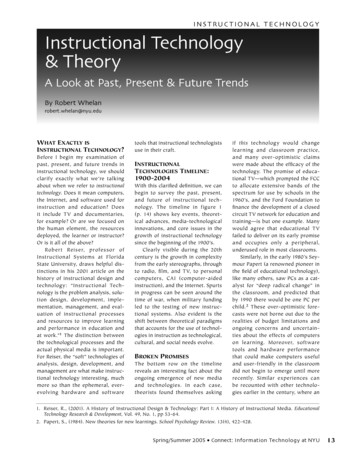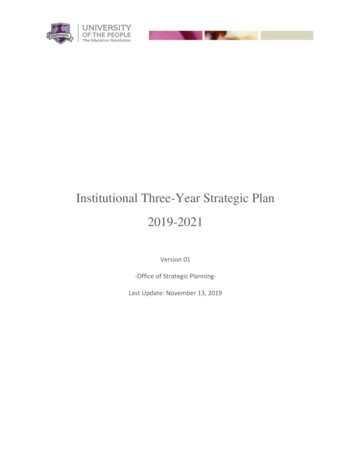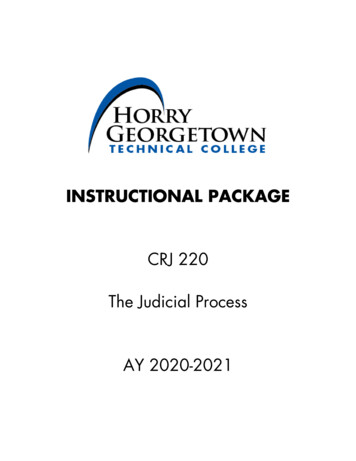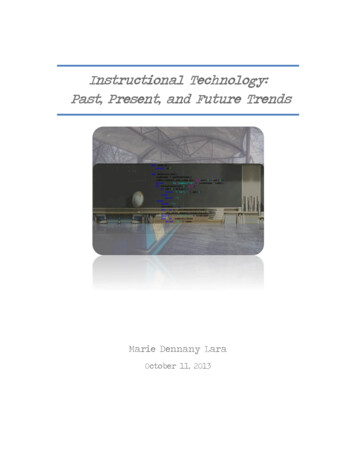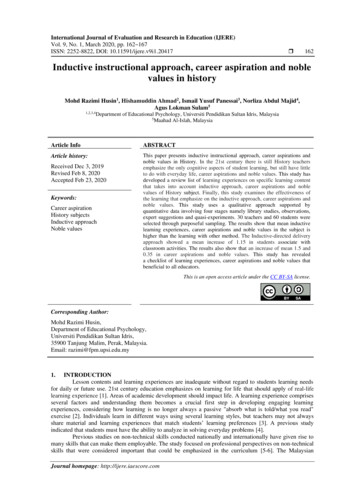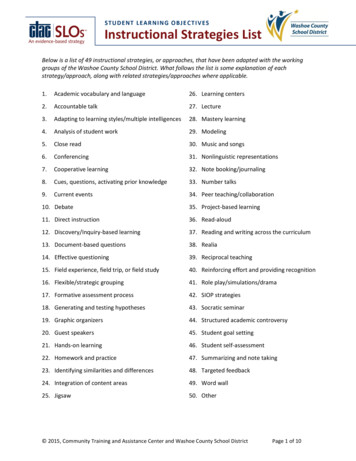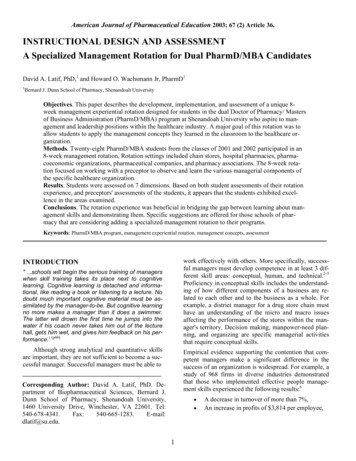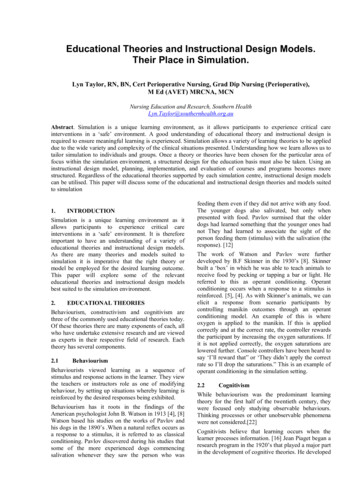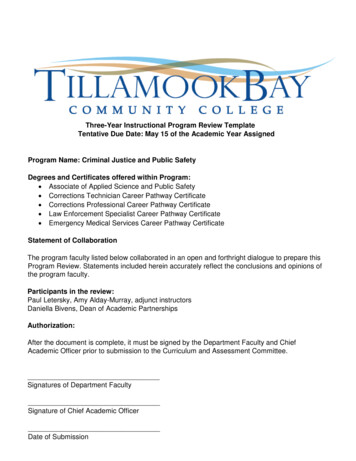
Transcription
Three-Year Instructional Program Review TemplateTentative Due Date: May 15 of the Academic Year AssignedProgram Name: Criminal Justice and Public SafetyDegrees and Certificates offered within Program: Associate of Applied Science and Public Safety Corrections Technician Career Pathway Certificate Corrections Professional Career Pathway Certificate Law Enforcement Specialist Career Pathway Certificate Emergency Medical Services Career Pathway CertificateStatement of CollaborationThe program faculty listed below collaborated in an open and forthright dialogue to prepare thisProgram Review. Statements included herein accurately reflect the conclusions and opinions ofthe program faculty.Participants in the review:Paul Letersky, Amy Alday-Murray, adjunct instructorsDaniella Bivens, Dean of Academic PartnershipsAuthorization:After the document is complete, it must be signed by the Department Faculty and ChiefAcademic Officer prior to submission to the Curriculum and Assessment Committee.Signatures of Department FacultySignature of Chief Academic OfficerDate of Submission
1.0 Mission and Goals1.1 Briefly describe the relationship of your program to the college’s Mission, Vision, and CoreThemes.College Mission & VisionCriminal Justice, Public Safety, and Law Enforcement professionals provide essential services totheir communities both locally and at state levels. They safeguard citizens, provide emergencymedical care and assure laws are obeyed. Curriculum course content encompasses the entirecriminal justice system; Policing, Courts, and Corrections and combines with the EMS academicsprogram that includes medical and physical training. Each contribute directly to the mission andvision of Tillamook Bay Community College (TBCC) by engaging the students through a learningprocess that involves critical thinking, active participation with law enforcement personnel andmedical service staff. Many classes are designed to transfer on to a four-year institution thatoffers similar coursework. The Criminal Justice and Public Safety curriculum is directed by anadvisory committee with professional representation for each of the course disciplines.Core ThemesThe TBCC Criminal Justice and Public Safety (CJ/PS) program encompasses all three corethemes; Education Excellence, Economic Success, Leadership, Partnership and CommunityEngagement. The CJ/PS student population reflects the community diversity and its programcourses address related issues serving in an equitable, inclusive and supportive environment.Many adjuncts and staff are mentoring students beyond classroom time, assisting them in careerpreparation and setting leadership examples. Police and medical emergency personnel require aspecial responsibility to adhere to moral duty, that obligation being inherent in their work. Wepromote respect and dignity for all; establishing relationships with the students and providingcourse content wherein the study of ethics is addressed for each profession in the criminaljustice and public safety system.Program DescriptionThe Tillamook Bay Community College offers programs in Criminal Justice and Public Safety toprepare students who wish to enter careers in those disciplines and ensures advancement forthose already employed who have earned our AAS Degree. The program combines a foundationof core requirements that total forty-one (41) credits with a selection of seventeen (17) electivecredits with a base degree requirement of fifteen (15) credits. Ninety (90) total credits arerequired for a degree. All courses prepare students with social norms, critical thinking, supportiveopinion practices, and technical writing, communication and judgement skills.The CJ/PS program offers Career Pathway Certificates in areas of; Corrections Technician,Corrections Professionals, Emergency Medical Services (EMT), and Law EnforcementSpecialists. The certificate supports the ability to immediately enter the workforce. Certificateholders can use credits earned to pursue an AAS Degree. Graduates with an Associate ofApplied Science Degree will be prepared to transfer to a four-year institution.
2.0 Program Data and Trends Analysis2.1 For each data point listed below, summarize the trend. (Attach three year longitudinal data toappendix.)Program Name: Criminal Justice and Public SafetyTableTrend (2016-2018)Data PointHighestYearEnrollment2.1.aProgram experienced the highest enrollment in2017 and has held steady around 200 enrollmentfor 2016 and 20182017NumberProgramMajors2.1.bThe trend remains steady for all three yearshovering between 15-26, with an influx in 2017which appears to be directly correlated to theincreased enrollment at the college as a whole2017Total FTE2.1.cParallel to the previous data points for Enrollmentand Program Majors, FTE data varied between 1825 FTE per year.2017NumberSectionsOffered2.1.dCriminal Justice is an expansive program thatencompasses multiple industry specific pathwaysunder one umbrella. Due to the unique needs ofthe program there were 44 sections offered duringthis period. The program offerings remainedconsistent at 41 during the 2017-2018 academicyears.20172018FTEF2.1.eThis is calculated excluding the summer term, sothe FTE totals below are slightly smaller than thetotals for the entire year. The average over thethree year period is .4435 which is just below a .5Faculty Member.2017(.5239)Fill Rate2.1.fThe three year fill rate average is (32.3%) with ahigh in 2017 of 35.1% fill rate. This skews thenumbers slightly as the overall average hoversaround 30-31% annaually.2017(35.1%)WSCH/FTEF2.1.gWeekly student contact hours per full timeequivalent faculty (WSCH/FTEF) is a productivitymeasure to evaluate the impact full-time facultyhave on the FTE generation for the college. For2016(2241.74)
this data, the typical convention nation-wide is touse 510 (number of hours associated with oneFTE) as a comparative measure. This wouldindicate that one full time faculty is generating oneFTE, roughly, per week for the college. For two ofthe three years, CJ enrollment averaged around2225.7, with a high year of 2241 in 2016. Thisaligns with the college’s strategic plan to furtherevaluate the program and determine a sustainablecoordinating plan based on program need.% StudentsPersistingfrom Fall toFall2.1.h42.3%When evaluating the cohort by gender – and wesee that among CJA majors the retention rate is31% for women, compared to 54% for men. Thisincludes only 26 students, so we shouldn’t maketoo much of this difference. Similarly, we cancompare the retention rates for CJA majors basedon race. The retention rate for Latinx CJA majors isquite high – 83%. But again, there are only 6Latinx students who are CJA majors in total, so wecan’t make a lot out of this. Overall CJA has aretention rate of 42.3% where the colleges overallaverage rate for the same period ran 34.9%. Thisis a 7.4% increase over the average retention ratefall to fall e average course pass rate is 90.2%, themajority of the 44 courses offered over the threeyear period had an 80% pass rate with 38/44courses above 80%.90.2%2.2 Program Peer ComparisonHow does your program compare with peers? (Peers include similar programs at thecollege or programs at peer institutions as identified by the Office of Institutional Research)Program Name: Criminal Justice and Public SafetyCollegeSouthwesternOregon CommunityCollege stingfrom Fallto FallAverageSuccessfulCompletionRate of cohort8NONEN/A3%
SouthwesternOregon CommunityCollege (2017-2018)SouthwesternOregon CommunityCollege (2018-2019)Tillamook Bay CC2016-2017Tillamook Bay CC2017-2018Tillamook Bay CC2018-20192427NONEN/A2.8%23120NONEN/A8.6%205(15 CJAmajordeclared)2NONEN/A1% (13.3% ofmajordeclared)275(26 CJAmajordeclared)208(18 CJAmajordeclared)34N/A2.5% (26.9%of majordeclared)23N/A8.6%(27.7% ofmajordeclared)Analysis:Based on similar attributes such a size, geographic location and student population, the mostcomparable colleges with Criminal Justice and Public Safety programs are Treasure Valley(TVCC), Columbia Gorge (CGCC), Umpqua (UCC), and Southwestern Oregon (SWOCC).Program leaders were contacted from all of the four community college of which one was able toprovide information at this time about their program (SWOCC).The data suggests that completion rate (by major) is actually increasing, which is a positive sign.The data is skewed, because many students take a CJ course, but most of these are not trulymajors. However, for majors, completion is increasing and positive in comparison to our neighborschools.We were able to get a three year look at our partner institution to the south and compare it withoutput data from TBCC. Through this analysis we were able to determine that our program datawas very similar in all measurable aspects of the review and followed the same cyclical cycles aswell. In order to complete a comprehensive peer comparison the department will reach back outto our partner institutions both at SWOCC and the other colleges indicated to ask for additionalinformation about: Content areas under the program umbrella Specifics about degrees and career pathways within the program Curriculum changes on the horizon2.3 Student Enrollment and Achievement by Gender and Race/Ethnicity
Analyze the achievement levels for each of the groups listed below. Are there differencesin achievement levels across groups? Are there strategies you can implement to providemore support for these populations?(Attach to Appendix or provide below the Persistence and Success Rates by Gender andRace/Ethnicity as identified by the Office of Institutional Research)Program Name:GroupCriminal Justice and Public SafetyNumber of StudentsEnrolledMalesFemales% Students Persisting from Average Successful COURSEFall to FallCompletion -AmericanAfrican-AmericanFilipinoHispanicNative AmericanOther Non-WhitePacific IslanderWhiteUnknownTotalAnalysis:With the data collected there are a couple of items that are of interest:1. It appears course enrollment and achievement by gender are fairly balanced. However,the persistence rates for males (54%) is significantly higher than females at a difference of23%. Having said that, women complete courses at a slightly higher rates than their malecounterparts.2. LatinX students make up less than 1/3 of the class enrollment but persist at 47% higherfall to fall then their white peers. The gender break down was not available for this data.3. Minorities successfully complete these courses at the same rate, relatively, as white peers(85 vs 86%).2.4 (CTE Programs Only) List the certifications students are able to earn throughparticipation in your program.Currently students can receive the EMS certificate and can test for Police Officer training.2.5 Other DataPlease include any other data (internal or external) that may be relevant to student achievement,learning, and trends within your Basic Skills, CTE, or Transfer Education program.N/A
Analysis2.6 Strengths, Weaknesses, Opportunities, Challenges (SWOC)2.6.1 What are the strengths of your program as indicated in the above data? The program classes are small compared to other colleges, allowing for one-on-onesupport for the student.Strong connections with law enforcement, courts, corrections, and medical servicepersonnel.Adjuncts are all professionals, most with advanced degrees and others are highlytechnically skilled. They provide mentoring and offer real-world experience to thestudents. Current adjuncts serve as police officers, corrections officers, military personal,former federal law enforcement, the district attorney and sitting judges.The program uses online teaching tools effectively and efficiently, needed particularly forstudents who are working full-time and those who find difficulty in affording child care.Courses offered allow students to complete their degree within two years.New advisory board members possess the skills, knowledge, and practical experiencethat capture the essence of current career requirements and to update course contentwith an understanding of changing legislative issues and their effect on our curriculum.2.6.2 What are the weaknesses of your program as indicated in the above data? Difficulty in scheduling as we do not have sufficient historic data to predict the number offull-time student registration from term to term.Low number of students make data sampling less reliable and fluctuate significantly withrelatively little change.Many courses are offered only one section per term resulting in classes being availableonly once per year/every other year. Part-time students may have to wait a full year beforea needed prerequisite course is available to them.Rigorous program assessment and the completed RFI database, does not allow easily formeasureable progress on learning outcomes.Possible cross content of information over multiple courses.2.6.3 What are the opportunities for your program as indicated in the above data? Partnerships among school districts and colleges/universitiesLocal surveys of high school juniors and seniors reflect a high interest in pursuing careersin criminal justice and public safety. We are in the process of creating programs to exploitand encourage those statistical findings.Scholarship funding has exceeded applicants. This will enable us to market thoseofferings.New adjuncts and growing online expertise.2.6.4 What challenges exist for your program based on the above data?
Tillamook is the largest and poorest county in the State of Oregon. Consequently,students have to endure great travel distances in order to attend TBCC. Creatingtransportation options would help to recruit students from various parts of the county.To develop new courses to update and meet with current law enforcement, corrections,and legislative issues. New courses would contribute to expanded student careeropportunities. During the interim we will incorporate required updates into existingcourses.To create social activities where students could participate and bring a fraternal sense ofpride to the college (i.e. clubs, sports competition between curriculum majors, offeringtrophies, awards, prizes, and various way of recognition). Activities that would keep themon campus after class and meet with fellow students.Process approval for new courses to minimize bureaucratic requirements and to expediteimplementation.3.0 Student Learning Outcomes Assessment3.1 How has assessment of course level SLOs led to improvements in student learningand achievement?The Program (PLO) and Course Learning Outcomes (CLO) were revised prior to 2016 to betteralign them with Institutional Learning Outcomes (ILO) and institutional aims. CLOs are assessedby CJA faculty through a Request for Information (RFI) each term utilizing course evaluations,exams, assignments, and student projects. The faculty and Advisory Members will be gettingtogether over the course of the coming year and regularly discuss course-level student outcomesand shared best practices associated with teaching and assessing CLOs. As a result, our goalwill be to update courses regularly with changes implemented to improve teaching strategies andstudent learning.While the newly implemented comprehensive assessment process started after the fall of 2017,through prior Request for Information (RFI), the following improvements to student learning wereidentified or implemented. As of Winter 2019 we are working diligently to ensure all courses areusing this process.3.2 How has assessment of program-level SLOs led to improvements in transfer orcertificate/degree awards?The intelligence disparity of students combined with instructors’ subjective evaluations could attimes distort the validity of the assessment process. Recognizing that possibility, we designedcourse content with topics addressing real-world and contemporary issues that relate with theTillamook community. This practice has resulted in positive Student Learning Outcomes anddeveloped a focus on what they will take from the program that enables them to immediatelycontribute to the community and its labor market.3.3 What challenges remain to make course and program level Student LearningOutcome Assessment more effective for your program?
The challenge to provide continuity of the program with legislative changes affecting lawenforcement practices and the community it serves. The introduction of new course content mustalso be consistent with those changes. The continuous monitoring of outcomes is triggered by arequirement to remain current in related teachings.4.0 Evaluation of Progress Toward Achievement of Previous Program Plans(Section 4.0 N/A 2017-18)4.1 Evaluate steps taken to achieve plans established in the last program review.This program has not completed program review at the college prior to now. This will be the firstfull cycle for program review. There has been significant work over the past year as we havebeen working through the process which has included: EMS (which is embedded in CJ) has worked through a comprehensive state audit Numerous meetings with key internal stakeholders Complete and update the current CJ Degree Map Advisory Committees have been formed and convened twice in the 2018-2019 academicyear Content and curriculum have been evaluated by program lead4.2 In cases where resources were allocated toward goals, evaluate the efficacy of thatspending.No additional resources were allocated towards program planned activities at this time. Uponcompletion of the fully program review there may be funding needs identified.5.0 Program Plans5.1 Short-term Plans (three year cycle)5.1.1 Based on the above data and analyses, identify 2 or more concrete plans, measurableoutcomes, and activities that you would anticipate resulting in improvements to the program inthe next three year cycle. Expand certificate offerings in the criminal justice program that would be extendedinto the Legal Profession. There are currently only four career pathway certificate offeringsin a limited field. Legal occupation positions are increasing at a 10% to 15% rate per year.These positions MAY include: Legal assistants, Legal support workers, Court, Municipaland License Clerks and Technical Writers. The legal certificate could also become aprerequisite to Paralegal studies. A full program evaluation and industry needsassessment will be completed prior to developing any additional certifications.Improve data gathering systems to allow for scheduling of courses that would enablestudents to receive their degree/certificate in a timely mannerUpdate course content material in several courses that would include:
o The “Formerly Incarcerated Reenter Security Transformed Safely TransitioningEvery Person Act”, commonly referred to as the “First Step Act”. This PrisonReform Bill was signed into law on December 21, 2018. It will have a profoundeffect on the entire criminal justice system.o Wrongful Conviction – Study of Causes and Preventions: This subject matter isclosely related to the First Step Act. Causes include, tunnel vision, eyewitnessmisidentification, false confessions, etc. Particular to “false guilty” pleas are certainat-risk-populations. An area of miscarriage of justice.o Cybersecurity: With cybercrime tipped to the greatest threat at this point of humanrevolution, it is estimated that cybercrime will cost the world 6 trillion annually by2021, up from 3 trillion in 2015. Criminal Justice and Business Administrationcannot ignore the impact cybercrime has on society as a whole.o Human Trafficking: A major serious criminal and humanitarian crisis occurring inthe State of Oregon of which most are unaware. It should be a must in ourcurriculum. These Trafficking issues need to be surfaced with an awareness to theTBCC c
(TVCC), Columbia Gorge (CGCC), Umpqua (UCC), and Southwestern Oregon (SWOCC). Program leaders were contacted from all of the four community college of which one was able to provide information at this time about their program (SWOCC). The data suggests that completion rate (by
